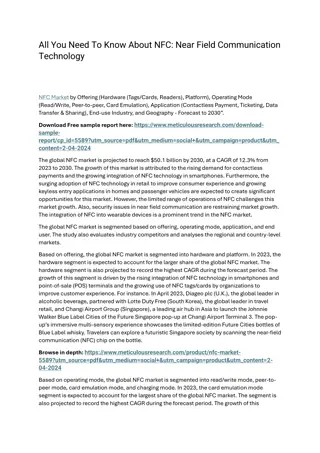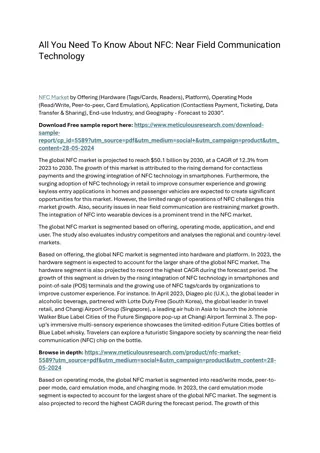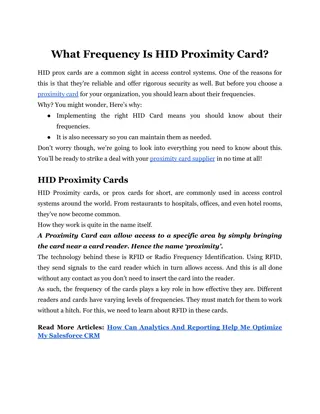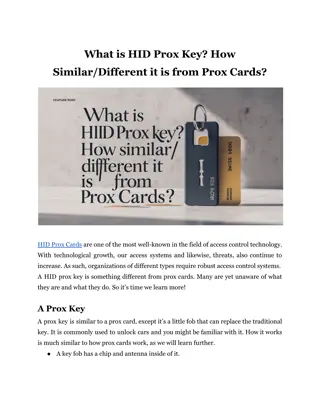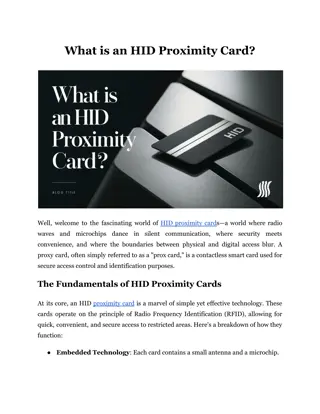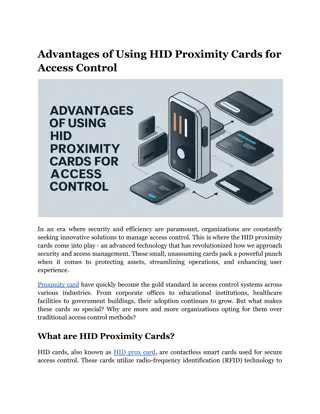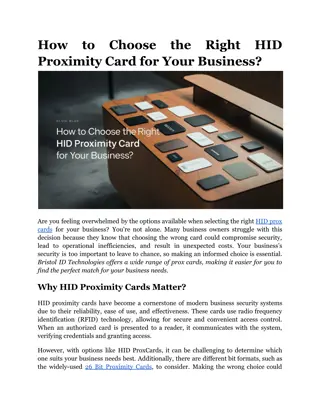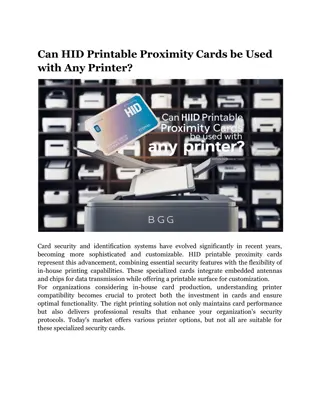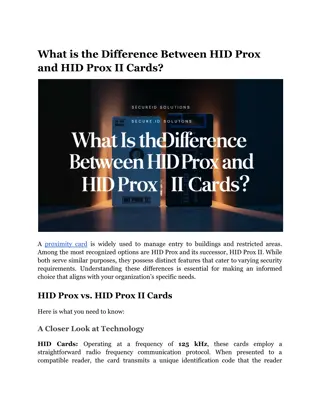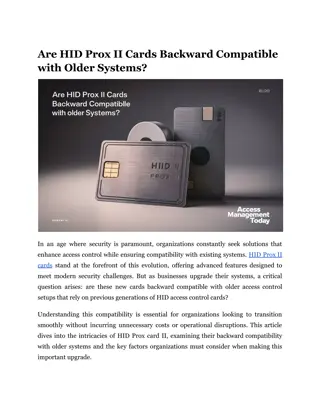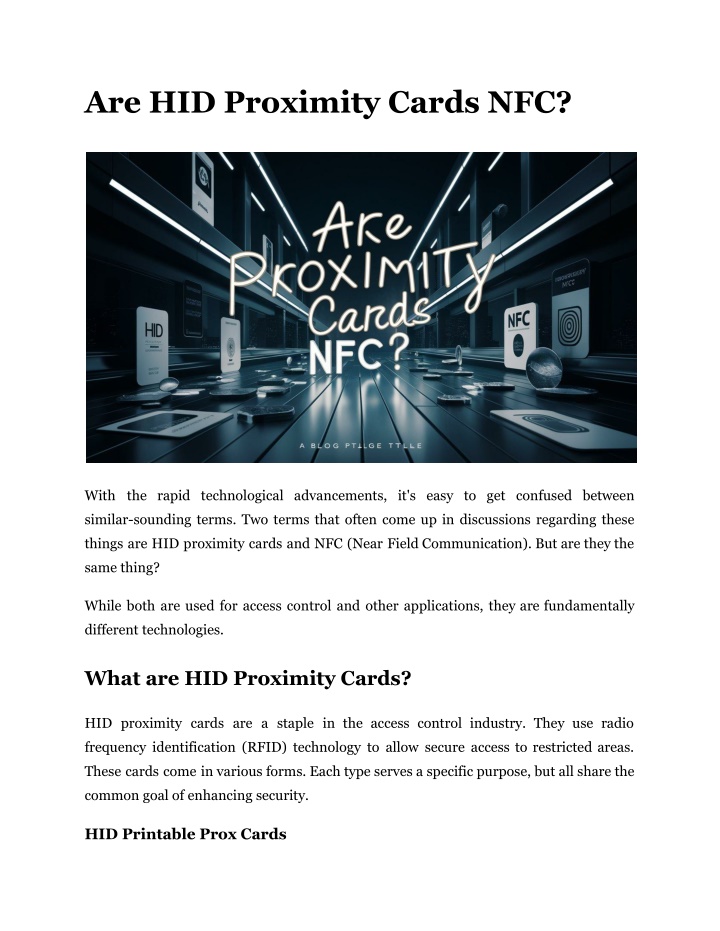
Are HID Proximity Cards NFC?
Discover if HID proximity cards use NFC technology. Learn key differences and find the best option for your access control needs.
Download Presentation

Please find below an Image/Link to download the presentation.
The content on the website is provided AS IS for your information and personal use only. It may not be sold, licensed, or shared on other websites without obtaining consent from the author. If you encounter any issues during the download, it is possible that the publisher has removed the file from their server.
You are allowed to download the files provided on this website for personal or commercial use, subject to the condition that they are used lawfully. All files are the property of their respective owners.
The content on the website is provided AS IS for your information and personal use only. It may not be sold, licensed, or shared on other websites without obtaining consent from the author.
E N D
Presentation Transcript
Are HID Proximity Cards NFC? With the rapid technological advancements, it's easy to get confused between similar-sounding terms. Two terms that often come up in discussions regarding these things are HID proximity cards and NFC (Near Field Communication). But are they the same thing? While both are used for access control and other applications, they are fundamentally different technologies. What are HID Proximity Cards? HID proximity cards are a staple in the access control industry. They use radio frequency identification (RFID) technology to allow secure access to restricted areas. These cards come in various forms. Each type serves a specific purpose, but all share the common goal of enhancing security. HID Printable Prox Cards
HID printable proximity cards can be printed with company logos, employee photos, and other identifying information. They enhance security just as well as they promote brand identity. Features of Printable Proximity Cards: Customizable printing options Enhanced security features Compatibility with most HID access control card systems Some types of these cards are: HID 37 Bit Prox Cards HID 37 bit proximity cards offer a higher level of security due to their increased bit length. These cards are often used in environments that require an extra layer of protection, such as financial institutions and data centers. Features: Higher bit length for increased security Compatibility with HID readers Robust and durable design HID proximity II Cards HID Prox II cards are an evolution of the original HID proximity cards, offering improved performance and reliability. They are widely used in various industries for secure access control. Features Of Prox 2 Cards: Enhanced read range Improved reliability and performance Other types:
HID iCLASS: These cards operate at a higher frequency and provide enhanced security features, including encryption and mutual authentication. HID Crescendo : A multi-technology card that combines proximity access with smart card capabilities, allowing for secure transactions and data storage. HID Smart ISOProx II: This card features a contact-based smart chip embedded within a proximity card, offering versatility for organizations needing both access control and data management. Read More Articles: The Hidden Risks of Proximity Cards: What You Need to Know Applications of HID Proximity Cards HID access control cards are widely used in various sectors, including: Corporate Offices: For employees, ensuring that only authorized personnel can enter secure areas. Educational Institutions: To manage access to buildings and resources, enhancing campus security. Healthcare Facilities: For secure access to sensitive areas, protecting patient data, and ensuring compliance with regulations. Government Buildings: To control access to secure facilities, ensuring only vetted personnel can enter. What is NFC Technology? NFC, or Near Field Communication, is a technology that enables wireless communication between devices over short distances. It is widely used in contactless payment systems, smartphone applications, and more. Unlike HID proximity cards, which use RFID technology, NFC operates at a higher frequency and supports bidirectional communication. Key Features of NFC Technology:
Short-range communication (typically up to 4 cm) Supports bidirectional data transfer Commonly used in smartphones and contactless payment systems Comparing HID Proximity Cards and NFC Feature HID Proximity Cards NFC Cards Operating Frequency 125 kHz 13.56 MHz Communication Range Typically up to 10 cm Typically up to 4 cm Slower NFC compared to the Data Transfer Speed Faster data transfer Use Cases Access control, ID badges Payments, data exchange Security Features Limited encryption Advanced security protocols Choosing the Right Technology for Your Needs When deciding between HID proximity cards and NFC-enabled smart cards, consider the following factors: Security Requirements If your organization requires basic access control, HID proximity cards may be sufficient. However, for high-security environments, or those needing multi-factor authentication, NFC-enabled smart cards offer superior protection. Existing Infrastructure Consider your current reader infrastructure. Upgrading to NFC-enabled cards may require replacing existing readers, which can be a significant investment.
Future Scalability NFC technology offers more possibilities for future expansion, such as integration with mobile devices or multi-application use cases. Budget Constraints While NFC-enabled smart cards offer more features, they come at a higher cost. Evaluate your budget and long-term security goals to determine the best fit. User Experience NFC-enabled cards can provide a more seamless experience, especially when integrated with mobile devices. However, traditional HID proximity cards are simple and familiar to many users. Read More Articles: Barossa Valley: One of Australia s Oldest and Premier Wine Regions The Future of Access Control As technology continues to evolve, we can expect to see further integration of NFC and other advanced technologies in access control systems. Some trends to watch include: Mobile Access Control The use of smartphones as access credentials is becoming increasingly popular, leveraging NFC technology for secure and convenient access. Biometric Integration NFC-enabled cards may be combined with biometric data for enhanced multi-factor authentication.
Internet of Things (IoT) Integration Access control systems may become more interconnected with other building systems. This creates smarter and more efficient environments. Artificial Intelligence and Machine Learning These technologies may be used to enhance security by detecting unusual access patterns and potential threats. So, What s The Conclusion? While HID proximity cards are not NFC, they remain a reliable and cost-effective solution for many access control applications. However, as security needs evolve and technology advances, NFC-enabled smart cards offer enhanced features and future-proofing capabilities that may be worth considering for your organization. Whether you choose to stick with traditional HID proximity cards or upgrade to NFC-enabled solutions, it s up to you. The key is to align your access control technology with your specific requirements. If you need more information or assistance in choosing the right HID proximity cards for your business, contact Bristol ID Technologies. Experts here are waiting to help you out. Site Article: Are HID Proximity Cards NFC?


